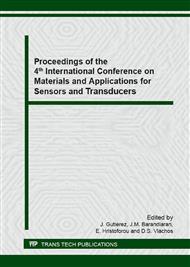[1]
Ogata K Modern Control Engineering (Upper Saddle River: Prentice Hall, 2009).
Google Scholar
[2]
Nise N S Control Systems Engineering (Danvers: John Wiley & Sons, Inc., 2008).
Google Scholar
[3]
Otero T F and Martinez J G Biomimetic intracellular matrix (ICM) materials, properties and functions. Full integration of actuators and sensors J. Mater. Chem. B 1 26–38 (2013).
DOI: 10.1039/c2tb00176d
Google Scholar
[4]
Pei Q and Inganas O Electrochemical Applications of the Bending Beam Method . 1. Mass-Transport and Volume Changes in Polypyrrole During Redox J. Phys. Chem. 96 10507–14 (1992).
DOI: 10.1021/j100204a071
Google Scholar
[5]
Otero T F, Angulo E, Rodríguez J and Santamaría C Electrochemomechanical properties from a bilayer: polypyrrole / non-conducting and flexible material — artificial muscle J. Electroanal. Chem. 341 369–75 (1992).
DOI: 10.1016/0022-0728(92)80495-p
Google Scholar
[6]
Amb C M, Dyer A L and Reynolds J R Navigating the Color Palette of Solution-Processable Electrochromic Polymers Chem. Mater. 23 397–415 (2011).
DOI: 10.1021/cm1021245
Google Scholar
[7]
Irvin J A, Irvin D J and Stenger-Smith J D Electroactive Polymers for Batteries and Supercapacitors Handbook of Conducting Polymers vol 2, ed T A Skotheim, R L Elsenbaumer and J R Reynolds (Boca Raton: CRC Press, 2007).
Google Scholar
[8]
Snook G A, Kao P and Best A S Conducting-polymer-based supercapacitor devices and electrodes J. Power Sources 196 1–12 (2011).
DOI: 10.1016/j.jpowsour.2010.06.084
Google Scholar
[9]
Svirskis D, Travas-Sejdic J, Rodgers A and Garg S Electrochemically controlled drug delivery based on intrinsically conducting polymers J. Controlled Release 146 6–15 (2010).
DOI: 10.1016/j.jconrel.2010.03.023
Google Scholar
[10]
Schmidt C E, Shastri V R, Vacanti J P and Langer R Stimulation of neurite outgrowth using an electrically conducting polymer Proc. Natl. Acad. Sci. U. S. A. 94 8948–53 (1997).
DOI: 10.1073/pnas.94.17.8948
Google Scholar
[11]
Ariza M J and Otero T F Nitrate and chloride transport through a smart membrane J. Membr. Sci. 290 241–9 (2007).
Google Scholar
[12]
Pellegrino J The Use of Conducting Polymers in Membrane-Based Separations Ann. N. Y. Acad. Sci. 984 289–305 (2003).
Google Scholar
[13]
Isaksson J, Tengstedt C, Fahlman M, Robinson N and Berggren M Solid-state organic electronic wettability switch Adv. Mater. 16 316–9 (2004).
DOI: 10.1002/adma.200306131
Google Scholar
[14]
Ahuja T, Mir I A, Kumar D and Rajesh Biomolecular immobilization on conducting polymers for biosensing applications Biomaterials 28 791–805 (2007).
DOI: 10.1016/j.biomaterials.2006.09.046
Google Scholar
[15]
Otero T and Cortes M Artificial muscles with tactile sensitivity Adv. Mater. 15 279–82 (2003).
Google Scholar
[16]
Arias-Pardilla J, Plesse C, Khaldi A, Vidal F, Chevrot C and Otero T F Self-supported semi-interpenetrating polymer networks as reactive ambient sensors J. Electroanal. Chem. 652 37–43 (2011).
DOI: 10.1016/j.jelechem.2010.12.002
Google Scholar
[17]
Ismail Y A, Martínez J G, Al Harrasi A S, Kim S J and Otero T F Sensing characteristics of a conducting polymer/hydrogel hybrid microfiber artificial muscle Sens. Actuators B Chem. 160 1180–90 (2011).
DOI: 10.1016/j.snb.2011.09.044
Google Scholar
[18]
Conzuelo L V, Arias-Pardilla J, Cauich-Rodríguez J V, Smit M A and Otero T F Sensing and Tactile Artificial Muscles from Reactive Materials Sensors 10 2638–74 (2010).
DOI: 10.3390/s100402638
Google Scholar
[19]
Valero L, Arias-Pardilla J, Cauich-Rodríguez J, Smit M A and Otero T F Characterization of the movement of polypyrrole–dodecylbenzenesulfonate–perchlorate/tape artificial muscles. Faradaic control of reactive artificial molecular motors and muscles Electrochimica Acta 56 3721–6 (2011).
DOI: 10.1016/j.electacta.2010.11.058
Google Scholar
[20]
Valero L, Arias-Pardilla J, Smit M, Cauich-Rodríguez J and Otero T F Polypyrrole free-standing electrodes sense temperature or current during reaction Polym. Int. 59 337–42 (2010).
DOI: 10.1002/pi.2750
Google Scholar
[21]
García-Córdova F, Valero L, Ismail Y A and Otero T F Biomimetic polypyrrole based all three-in-one triple layer sensing actuators exchanging cations J. Mater. Chem. 21 17265–72 (2011).
DOI: 10.1039/c1jm13374h
Google Scholar
[22]
Gimenez P, Mukai K, Asaka K, Hata K, Oike H and Otero T F Capacitive and faradic charge components in high-speed carbon nanotube actuator Electrochimica Acta 60 177–83 (2012).
DOI: 10.1016/j.electacta.2011.11.032
Google Scholar
[23]
Mukai K, Asaka K, Hata K, Fernandez Otero T and Oike H High-Speed Carbon Nanotube Actuators Based on an Oxidation/Reduction Reaction Chem. - Eur. J. 17 10965–71 (2011).
DOI: 10.1002/chem.201003641
Google Scholar
[24]
Martinez J G, Sugino T, Asaka K and Otero T F Electrochemistry of Carbon Nanotubes: Reactive Processes, Dual Sensing-Actuating Properties and Devices Chemphyschem 13 2108–14 (2012).
DOI: 10.1002/cphc.201100931
Google Scholar
[25]
Martínez J G, Otero T F, Bosch-Navarro C, Coronado E, Martí-Gastaldo C and Prima-Garcia H Graphene electrochemical responses sense surroundings Electrochimica Acta 81 49–57 (2012).
DOI: 10.1016/j.electacta.2012.07.037
Google Scholar
[26]
Otero T F Conducting Polymers, Electrochemistry, and Biomimicking Processes Modern Aspects of Electrochemistry Modern Aspects of Electrochemistry ed R E White, J O Bockris and B E Conway (New York: Springer US, 1999) p.307–434.
DOI: 10.1007/0-306-46917-0_3
Google Scholar
[27]
Otero T F, Sanchez J J and Martinez J G Biomimetic Dual Sensing-Actuators Based on Conducting Polymers. Galvanostatic Theoretical Model for Actuators Sensing Temperature J. Phys. Chem. B 116 5279–90 (2012).
DOI: 10.1021/jp300290s
Google Scholar
[28]
Martinez J G and Otero T F Biomimetic Dual Sensing-Actuators: Theoretical Description. Sensing Electrolyte Concentration and Driving Current J. Phys. Chem. B 116 9223–30 (2012).
DOI: 10.1021/jp302931k
Google Scholar
[29]
Martinez J G and Otero T F Mechanical awareness from sensing artificial muscles: Experiments and modeling Sens. Actuators B Chem. 195 365–72 (2014).
DOI: 10.1016/j.snb.2013.12.099
Google Scholar
[30]
Abramowitz M (editor) and Stegun I A (editor) Handbook of mathematical functions with formulas, graphs, and mathematical tables (New York: Dover, 1964).
DOI: 10.2307/2282672
Google Scholar
[31]
Otero T F and Cortes M T Artificial muscle: movement and position control Chem. Commun. 284–5 (2004).
Google Scholar
[32]
Otero T F and Sansiñena J M Bilayer dimensions and movement in artificial muscles Bioelectrochem. Bioenerg. 42 117–22 (1997).
DOI: 10.1016/s0302-4598(96)05112-4
Google Scholar


